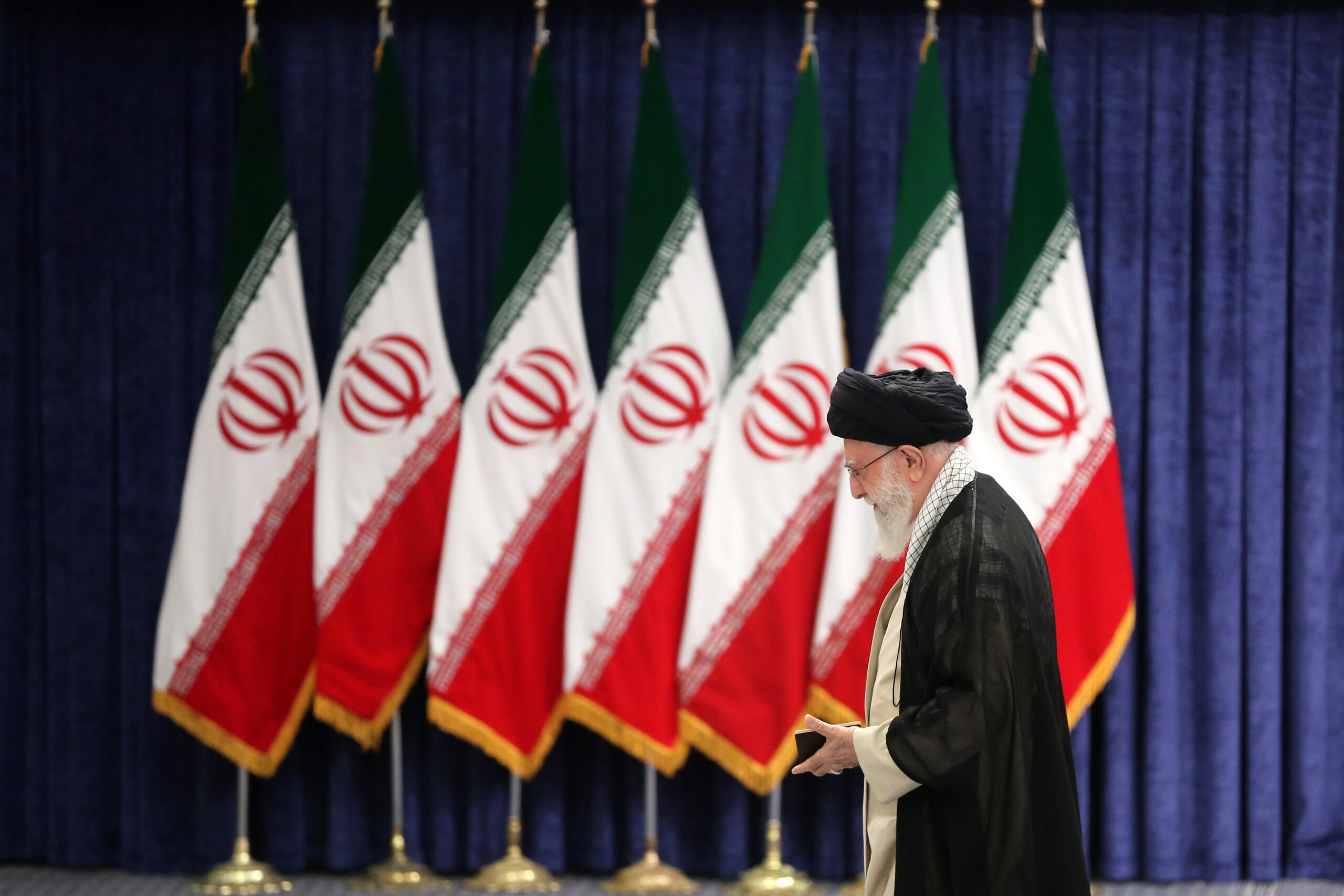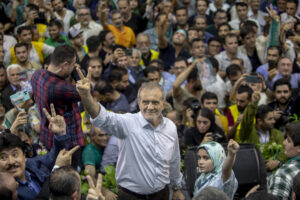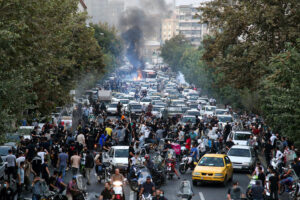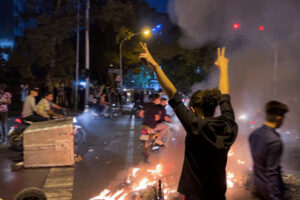
The country’s recent elections revealed deep fissures in Iranian society and there is already growing disillusionment with the new president. With mounting economic worries, Iran is in a volatile state.
September 2024
Iran’s 2024 presidential election — the first since the mass protests of 2022 — was in some ways an anomaly: Voter turnout in the first round was the lowest in the Islamic Republic’s history at 39.9 percent, rising to just 49.8 percent in the second round, and the outcome left no faction fully satisfied. The supreme leader, Ayatollah Ali Khamenei, and the powerful Islamic Revolutionary Guard Corps (IRGC) failed to propel the candidate widely perceived as their preferred choice into the runoff. And since most reformists could not pass the Islamic Republic’s stringent vetting process, they were forced to rally behind a relatively obscure member of parliament named Masoud Pezeshkian. Although Pezeshkian won with 53.7 percent of the vote, his victory was comparatively weak. Gone are the days when reformists could secure some 70 percent of the vote with 80 percent turnout, as they did in 1997. Years of regime brutality, coupled with the reformists’ ineffective policies, have left Iranians disillusioned with elections.
The Islamic Republic’s vetting process guarantees that only candidates aligned with the system — especially the supreme leader and the IRGC — can run for office and win. Yet even elections such as these serve several purposes: They project a semblance of democracy to the outside world; they help manage internal elite competition; and they offer citizens a controlled outlet for grievances that might otherwise trigger protests. By combining voter participation with internal conflict management, the regime attempts to enhance its legitimacy, stability, and security.
Yet despite controlling who can run, the Islamic Republic does not have total control over electoral outcomes. Elite coalitions and voters can outmaneuver the system by rallying behind the candidate perceived as least loyal to the regime, thereby transforming the election into a social movement. Additionally, low voter turnout can cast doubt on the winner’s legitimacy. The state is thus trapped in a constant dilemma: Relaxing the vetting process might increase participation, but it would also risk elevating a candidate who does not align with the regime or, worse, mobilizing public support to challenge it. Conversely, a tighter vetting process would guarantee loyal candidates but risk low turnout, which could expose the system’s fragility and deepen elite conflicts. Elections in Iran are therefore a delicate balancing act for the Islamic Republic as it attempts to secure both high voter participation and a loyal candidate, but fails to fully achieve either.
A Contest Without Winners
The 2024 contest revealed deep divisions in society, with almost half the country’s electorate abstaining from voting in the second round, 26 percent of eligible voters supporting reform (by voting for Pezeshkian), and 22 percent favoring the status quo (by voting for his ultraconservative rival, Saeed Jalili). In stark contrast to previous elections that turned into movements — such as the 1997 groundswell of support that elected Mohammad Khatami to the presidency and the 2009 Green Wave backing Mir Hossein Mousavi, who many believed was fraudulently denied office — this year the electorate was unable to push for meaningful political, economic, or social transformation. While Khatami and Mousavi failed to convert their grassroots momentum into leverage for democratic change, Pezeshkian lacked the popular backing that could provide him with such leverage in the first place.
Yet each actor in the 2024 political drama has managed to extract some form of payoff from this outcome. For Khamenei and the IRGC, the reformist candidate’s win mitigated a legitimacy crisis that a noncompetitive election would have exacerbated and avoided inviting increased international pressure. The supreme leader and the IRGC will retain control over critical institutions and policy matters (the president’s “prerogatives are merely administrative”) while keeping their conservative base hopeful for future electoral victories.
Meanwhile, the reformists, marginalized for two decades, finally reentered the corridors of power, gaining a foothold in the government and participating in agenda setting. In the broader society, there was a heated debate about whether to vote or boycott the election. Many felt that voting would only legitimize a corrupt process that inevitably favored the regime, while others saw participation as the only way to push for incremental change. Through this mix of boycott and participation, the public demonstrated its enduring agency — whether by abstaining and actively denying the regime legitimacy or by reluctantly voting in hopes of influencing outcomes. And ultimately the abysmal turnout — especially in the first round, and for the third election in a row — did compel the regime, now desperate to draw citizens back to the ballot box and avert unrest, to make some concessions.
This mixed outcome has produced a temporary and potentially volatile state that is not optimal for any party involved, and it has left politicians and experts alike divided over its cause and consequences. There are two competing interpretations of what the political leadership intended with this contest: Either it was a genuine concession to popular demands, or it was a calculated act of cooptation designed to perpetuate the status quo.
Regime Concession or Cooptation?
Was the leadership’s decision to allow a nonsubversive reformist to participate in the election a concession born of necessity? The regime’s previous strategy of purging reformists — exemplified by the 2021 engineered election of conservative Ebrahim Raisi as president and the March 2024 parliamentary elections that led to the ascendance of ultraconservatives — had only exacerbated Iran’s political, economic, and social problems. With record-low turnouts, the gap between state and society widened. This was most visibly demonstrated by the protests that erupted in 2022 after the death of Mahsa Amini in police custody. Faced with these challenges and needing to increase voter participation, rebuild society’s trust, and reintegrate more experienced bureaucrats into state institutions, Khamenei and the IRGC seized the opportunity presented by the sudden death of President Raisi in a May helicopter crash to make a concession: They permitted reformists to run to replace Raisi.
A key piece of evidence supporting this view is Khamenei’s unusual and direct instruction to the conservative-dominated Majlis (parliament) to cooperate with the new president. Traditionally, the regime has used the body to obstruct moderate presidents’ initiatives. The supreme leader’s pointed statement, however, emphasized that the Majlis must be held accountable for its own actions while also holding the government to account. This could suggest that the system is seeking to compromise and navigate this new era with greater flexibility.
Khamenei’s warning enraged the radical wing of conservatives, who now feel betrayed by the Islamic Republic after years of loyalty. These ultraconservatives, who have enjoyed regime protection while attacking peaceful protesters and raiding foreign embassies in recent years, are now questioning their own role as “useful idiots” for the system.
The cooptation argument, in contrast, points to the fact that Pezeshkian did not identify as a reformist during his campaign and that reformists have largely abandoned their traditional platform of promoting democracy, human rights, and rapprochement with the West. The reformist movement has fragmented in the last few years, with some members advocating radical change and calling for an election boycott and others settling for minimalist policy adjustments aimed at alleviating daily hardships for citizens. A large share of the populace is un- or underemployed and struggling to make ends meet as inflation keeps rising and access to basic services keeps shrinking. In abandoning their core ideals, the minimalist reformists have effectively been coopted by the regime in exchange for a modest share of power in the election of Pezeshkian.
Pezeshkian’s own statements lend support to this view. During the campaign, he stressed that the president’s role is simply to implement the policies set by the supreme leader and later acknowledged that without Khamenei’s support, he probably wouldn’t have been elected. During parliamentary hearings for his cabinet, Pezeshkian emphasized that he had not assembled an ideal team, but rather one that could gain approval from key institutions, including the supreme leader’s office and the IRGC’s intelligence office. The new president revealed that some of his cabinet members were not only approved but specifically chosen by Khamenei. Consequently, the parliament approved them all — a rare occurrence — demonstrating the extent of the regime’s influence over and cooptation of reformists, rather than a genuine commitment to change.
Many are already disillusioned with Pezeshkian, viewing his actions as a betrayal of the reformists’ core principles. Yet some reformists are calling for pragmatism. In a letter to former president Mohammad Khatami, prominent reformist figure Abbas Abdi urged the “radical and combative” wing of the faction to move beyond heroism — that is, bold, risky, idealistic actions in pursuit of maximalist demands — and argued that such challenges had only antagonized the regime, increased repression, depleted political forces, and impeded effective reforms. Interestingly, Abdi was once among the radicals himself, not only for his role during the 1979 U.S. Embassy occupation but also for his later criticism of Khatami’s presidency (1997–2005) for being too conciliatory toward the regime.
The Path Forward
Recent developments since Pezeshkian’s inauguration lend credence to the view that the regime’s actions are more about cooptation than genuine concession. Although Pezeshkian initially emphasized the importance of reviving the now-defunct 2015 nuclear deal (the Joint Comprehensive Plan of Action) and pursuing balanced relations with both East and West, his foreign-policy team, which is composed of diplomats who had negotiated the deal, is echoing the previous administration’s conservative foreign-policy stance. They assert that the deal is dead in its current form and would rather prioritize relations with neighboring countries, nonstate allies, Russia, China, and the Global South.
By using elections to manage state-society tensions, the Islamic Republic offers a controlled channel for the expression of grievances while addressing select demands such as economic reforms or easing social restrictions to placate key segments of the populace. This allows the government to diffuse dissent without fully relinquishing power. Coopting elites, meanwhile, helps the Islamic Republic to navigate the country through critical junctures, including the leadership transition that will follow the eventual death of the 85-year-old Ayatollah. As Abbas Akhoundi, a reformist figure disqualified from running in the presidential election, recently warned more optimistic reformists, once the regime gains more control, it is likely to engage in even more brutal repression and purges to eliminate any elements that might one day threaten its authority.
Yet events on the ground could shift the dynamics, potentially convincing the regime to make some meaningful reforms and concessions. If Pezeshkian can successfully address three key issues that he highlighted in his campaign — internet censorship, government repression, and economic hardship — it could enhance reformists’ credibility and popularity. He could begin by lifting bans on social media, disbanding the morality police that enforces the women’s dress code, and alleviating economic hardships by tackling corruption and negotiating to ease U.S. sanctions. By fostering a degree of mutual trust and minimal legitimacy for the government through such measures, Pezeshkian might be able to begin delivering on his promises and to implement difficult but necessary economic reforms that might otherwise provoke the type of instability and unrest that occurred in 2019, when the government abruptly increased gas prices, triggering widespread protests that were met with brutal repression.
It is becoming increasingly apparent that many of the disagreements within Iran’s political landscape are less about the substance of policy and more about who implements it. For instance, during the presidential debates, it was revealed that the conservatives’ opposition to an international financial transparency framework called the Financial Action Task Force stemmed not from ideological differences but from a reluctance to allow former centrist president Hassan Rouhani’s “pro-Western” team to handle its implementation.
A Dangerous Moment
Currently, Iran is grappling with a series of interconnected and chronic crises and imbalances across different sectors. This precarious situation has led to what former presidential economic advisor Masoud Nili has termed a “fear equilibrium.” In this state, the government, the private sector, and citizens all find themselves barely staying afloat, unable to withstand the shock of economic reform. The state is struggling to provide cheap energy and relies on unsustainable natural-resource exploitation, retirement funds are bankrupt, and inflation is at 40 percent. These problems are all interconnected, but reform in any one of the financial, environmental, or energy sectors could destabilize the others and spark unrest. Yet continuing on the current path could cause the country to crumble. As Nili warned, “There would be no Iran left.”
Given the widening state-society gap and the unpredictability generated by external pressures, any attempt at reform requires careful coordination built on trust within the state and between the state and society. Without that, even the most necessary changes could unravel the fragile balance that currently holds the country together. Abdi’s call for a departure from radicalism within the reformist camp suggests an awareness that the old paradigms — defined by stark factional battles between reformists and conservatives — may be reaching a dangerous point.
There is a growing call from reformists and state bureaucrats for greater institutional autonomy, particularly within the foreign-policy, judicial, media, and environmental arenas, claiming that such autonomy aligns with the nation’s collective interests. Their aim is to establish a functional balance without challenging the ultimate authority of the supreme leader and the IRGC. Such autonomy would allow institutions to develop initiatives and implement reforms more independently and effectively while still operating within the broader framework set by the system. The message to the political leadership is clear: Survival depends on adhering to rules that can improve governance, curtail corruption, and prevent public anger from escalating. As the new president has cautioned, “We are all in the same boat.”![]()
Mohammad Ayatollahi Tabaar is associate professor of international affairs at Texas A&M University’s Bush School of Government and Public Service, a visiting scholar at the Harvard Kennedy School’s Belfer Center, and a fellow at Rice University’s Baker Institute for Public Policy. He is the author of Religious Statecraft: The Politics of Islam in Iran.
Copyright © 2024 National Endowment for Democracy
Image credit: Fatemeh Bahrami/Anadolu via Getty Images
|
FURTHER READING |
||

The Empty Promise of Iran’s New PresidentMasoud Pezeshkian won’t be a “reformer” in any genuine sense. Like all Iranian presidents, he has pledged his loyalty to Iran’s supreme leader. What he really offers is a softer version of Iran’s grim repression. |

Is Iran on the Verge of Another Revolution?There have been numerous waves of protest against the country’s corrupt theocracy. This time is different. It is a movement to reclaim life. Whatever happens, there is no going back. |

Why Women Are Leading the Fight in IranIran’s women were the Islamic Republic’s first target for repression. This is the newest chapter in their struggle to win back their rights. |
